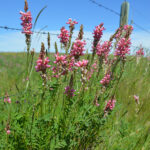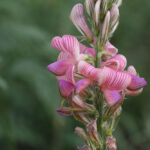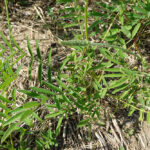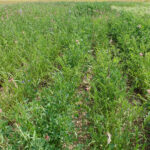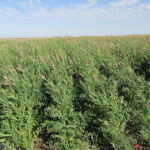Sainfoin
Onobrychis viciifolia
General Description
Sainfoin is a relatively short-lived, deep-rooted, non-bloating perennial legume able to withstand some drought. It can be useful in grazing systems because it is non-bloating and maintains good forage quality for late-season grazing or stockpiling. It has deep branching taproots with many small lateral roots, and a stout branched crown. Sainfoin’s erect, hollow stems can reach up to 100 cm (39 in) tall. Stems are very succulent and palatable in spite of their coarse appearance. There are 11 to 29 paired leaflets on each compound leaf. Sainfoin flowers are brilliant pink.
Type
Tame legume.
Origin
Origins in Europe, Russia, Turkey, and parts of Asia. Varieties developed in Canada.
Longevity
At least 5 years. Stand persistence is very dependent on crown survival.
Use
Pasture, hay, stockpiled.
Optimal Time of Use
Spring, summer, fall, winter. Often grazed in spring and early summer. Can be fall grazed after first killing frost through to winter. Hay at 50-100% bloom. Sainfoin maintains its nutritive quality into full bloom.
Recovery After Use
Sainfoin may recover in 60-80 days with favorable growing conditions, but normally allow a full season rest period after use. Sainfoin regrowth occurs from buds on remaining stems. It has poor tolerance to close and/or frequent grazing and is better suited to rotational rather than continuous grazing. To increase longevity, cut or graze leaving 30 cm (12 in) stubble and do not use during the last 4-6 weeks prior to frost (stockpiled grazing thereafter).
Palatability/Nutritional Value
Palatable with 18% protein during full bloom and 63% digestibility. Sainfoin is a non-bloating legume for livestock and when it is consumed in a mix with alfalfa it can reduce bloat (due to tannin levels in sainfoin). Its stems are generally more palatable than the stems of alfalfa.
Annual Precipitation min/max (mm)
300mm / 600mm
Drought Tolerance
Good drought tolerance. However, it is unable to sustain production during prolonged droughts.
Flooding Tolerance
Can withstand 1 week of flooding or saturated soils in the spring. Root and crown rot will limit stand longevity.
Winter Hardiness
Fair to good winter hardiness. Winter survival is improved when crowns are protected with vegetative cover and plant litter. Rest from grazing during the last 4-6 weeks prior to frost improves winter survival. Stockpiled grazing can begin post-frost.
Soil Texture Preference
Sainfoin is suited to well drained soils of all soil textures, even on gravelly or thin soils.
Erosion Control
Moderate ability to control erosion.
Salinity Tolerance
Not tolerant to salinity.
Acidity Tolerance
Slight tolerance. Tolerates soil pH levels as low as 6.0.
Alkalinity Tolerance
Good tolerance.
Seeds per kg
66,000 seeds/kg (30,000 seeds/lb)
Suggested Mixtures
Mixes well with less competitive grasses such as meadow bromegrass, Russian wildrye and crested wheatgrass. Sainfoin can be out-competed by grasses that are creeping-rooted once the grass becomes established. Sainfoin can be used in mixes to lower the bloat risks associated with alfalfa. Newer sainfoin varieties have improved stand persistence.
Ease of Establishment
Sainfoin germinates well when planted directly into the soil. It establishes slowly but satisfactorily. Cover crops can be a detrimental competitor to sainfoin seedlings. Some sources state that scarifying seed improves germination. Seeds are large and are often contained in seedpods. Seed should be planted shallow (<3/4 inch deep).
Competitiveness
Sainfoin is not competitive in many mixtures, but does well with bunchgrasses over the long term. Weeds and creeping rooted grasses can often out-compete sainfoin so plant health should be managed to maximize competitiveness.
Management Considerations
As a best practice, inoculate and scarify seed before establishing sainfoin. Manage sainfoin stands to maintain cover and promote healthy plant crowns. As a non-bloating legume for livestock, production advantages can be seen using sainfoin. Allowing seed set and drop can allow for new plants and a longer stand longevity.
British Columbia Rangeland Seeding Manual, Saskatchewan Dryland Forage Species Adaptation Tool, USDA Plants Database, Alberta Forage Manual, Manitoba Forage Adaptation and Comparison Guide
Sainfoin is adapted to the Sub-Boreal Spruce, Sub-Boreal Pine-Spruce and Interior Cedar-Hemlock zones. In the southern part of the Central Interior it is adapted to the Interior Douglas-fir zone, and to irrigated and subirrigated areas in the Bunchgrass zone. Sainfoin regrows from remaining leaves making it more suited to cooler areas in the region where 1-2 harvests are typical. New varieties are more competitive for use in mixed stands and have better tolerance to grazing.
Despite good drought tolerance Sainfoin is not well adapted to dryland use in the semi-arid parts of the Bunchgrass zone, but is adapted to all other areas in the region. Sainfoin regrows from remaining leaves making it more suited to cooler areas in the region where 1-2 harvests are typical. New varieties are more competitive for use in mixed stands and have better tolerance to grazing.
Sainfoin is adapted to the Peace-Liard region, although it is not widely used. It is not that competitive and therefore is not suited to mixtures with the more competitive grasses commonly used for pasture and hay in the Peace-Liard region. New varieties have improved competitiveness and emergence.
